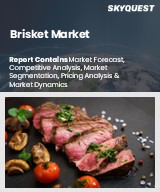
세계의 브리스킷 시장 규모는 2023년에 282억 달러로 평가되었으며, 2024년 295억 5,000만 달러에서 2032년에는 430억 달러로 성장하여 예측 기간(2025-2032년) 동안 CAGR 4.8%로 성장할 전망입니다.
세계 브리스킷 시장은 고단백 식품에 대한 소비자 수요 증가와 바비큐 문화의 활황에 힘입어 괄목할만한 성장세를 보이고 있습니다. 미국 농무부(USDA)는 전 세계적으로 쇠고기 소비가 견조한 가운데, 브리스킷은 다용도성, 풍부한 풍미, 슬로우 쿠킹에 이상적인 특성으로 인해 인기를 끌고 있다고 강조합니다. 주요 소비자는 30세에서 60세 사이의 성인이며, 특히 북미와 유럽 일부 지역과 같이 요리 전통이 강한 지역에서 주로 소비되고 있습니다. 그러나 브리스킷은 중저소득 국가에서는 보관 장소와 인지도가 제한적이고 가격이 비싸기 때문에 충분히 활용되지 못하고 있습니다. 이를 해결하기 위해 기업들은 지속가능한 조달, 합리적인 가격의 포장 및 타겟 마케팅 전략에 투자하여 브리스킷이 소외된 시장으로 확장할 수 있는 길을 열어 전체 시장의 성장을 지원하고 있습니다.
Global Brisket Market size was valued at USD 28.2 billion in 2023 and is poised to grow from USD 29.55 billion in 2024 to USD 43.0 billion by 2032, growing at a CAGR of 4.8% during the forecast period (2025-2032).
The global brisket market is witnessing significant growth, driven by increasing consumer demand for high-protein foods and the booming BBQ culture. The USDA highlights that beef consumption is strong worldwide, with brisket gaining popularity due to its versatility, rich flavor, and ideal characteristics for slow cooking. The primary consumers are adults aged 30 to 60, particularly in regions with robust culinary traditions such as North America and parts of Europe. However, brisket is underutilized in low and middle-income countries due to limited storage access, awareness, and high prices. To address this, companies are investing in sustainable sourcing, affordable packaging, and targeted marketing strategies, paving the way for brisket's expansion into these underserved markets and supporting overall market growth.
Top-down and bottom-up approaches were used to estimate and validate the size of the Global Brisket market and to estimate the size of various other dependent submarkets. The research methodology used to estimate the market size includes the following details: The key players in the market were identified through secondary research, and their market shares in the respective regions were determined through primary and secondary research. This entire procedure includes the study of the annual and financial reports of the top market players and extensive interviews for key insights from industry leaders such as CEOs, VPs, directors, and marketing executives. All percentage shares split, and breakdowns were determined using secondary sources and verified through Primary sources. All possible parameters that affect the markets covered in this research study have been accounted for, viewed in extensive detail, verified through primary research, and analyzed to get the final quantitative and qualitative data.
Global Brisket Market Segments Analysis
Global Brisket Market is segmented by Cut Type, Product Type, Packaging, End-Use and region. Based on Cut Type, the market is segmented into Point Cut and Flat Cut. Based on Product Type, the market is segmented into Conventional Brisket and Organic Brisket. Based on Packaging, the market is segmented into Box, Pouches and Others. Based on End-Use, the market is segmented into Retail and Foodservice. Based on region, the market is segmented into North America, Europe, Asia Pacific, Latin America and Middle East & Africa.
Driver of the Global Brisket Market
The global brisket market is being driven by the rising popularity of international BBQ culture, particularly in both developed and emerging economies. The demand for high-quality meats is surging as restaurants, food trucks, and culinary festivals specializing in smoked and grilled brisket become increasingly popular. By 2024, chains in the UK and South Korea, such as smoke house and TGI Fridays, have started incorporating smoked brisket platters into their menus, thus enhancing consumer awareness and encouraging more people to try this delicious cut of meat. This growing trend is significantly boosting brisket sales worldwide.
Restraints in the Global Brisket Market
The global brisket market is currently facing several constraints hindering its growth. Fluctuations in beef prices and inefficiencies in supply chains are major challenges. Transportation delays have increased operating costs and hindered product availability. Furthermore, in 2024, a decline in cattle inventory in the U.S., primarily due to severe drought conditions in Texas and the Midwest, has resulted in a significant 15% increase in wholesale beef prices, as noted in the USDA Report for Q4 2023. This price surge has adversely affected both restaurant and retail brisket pricing, consequently diminishing affordability and lowering consumer demand.
Market Trends of the Global Brisket Market
The global brisket market is witnessing a significant shift towards premium and grass-fed options, driven by an increasing consumer preference for quality and health-conscious choices. This trend is most pronounced in markets such as the U.S., UK, and parts of Europe, where there is a growing demand for ethically sourced meat. Health-aware consumers are willing to pay a premium for brisket that is perceived as healthier and more responsibly raised. In January 2024, JBS responded to this trend by launching its Swift Premium grass-fed brisket line in the U.S. and EU, targeting barbecue enthusiasts and consumers seeking high-quality meat, further solidifying the move towards quality-driven consumption in the brisket segment.